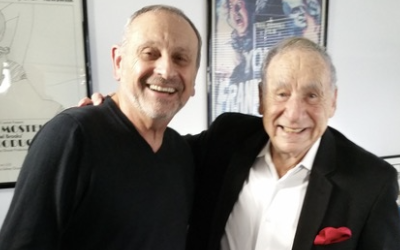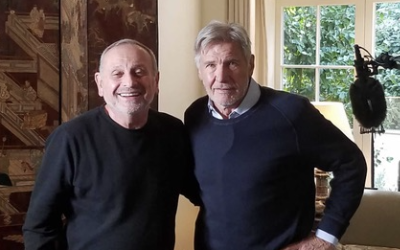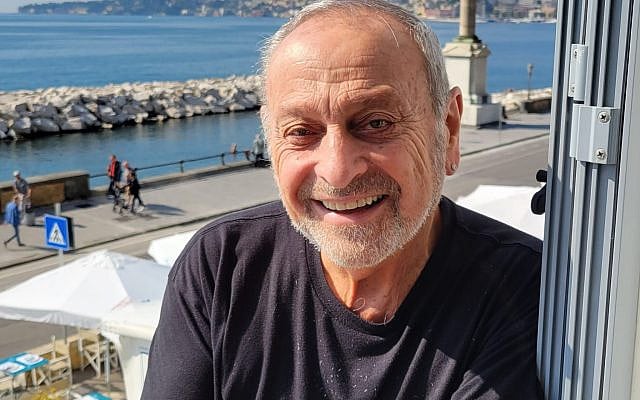Hollywood Veteran Turns to Jewish History
Stanley Isaacs, a seasoned filmmaker known for the last decade for chronicling Hollywood’s golden years, is now turning his lens to a deeper, more personal subject: the Jewish experience, or more so, the human experience with stories that encompass stories of love and hate, tragedy and triumph.
While others of his generation are winding down, Isaacs has teamed with producer Dan Kodsi to launch Envision Pictures. The companies mission statement is to bring history to life through timeless sagas that are thrilling spiritual journeys filled with love, suspense, and drama. Stories that seamlessly blend historical facts, written scripture, and omnipresent light. Each film will be crafted to entertain and illuminate, leaving audiences inspired and moved by true events that have shaped our world. Their first two projects are “8 Days of Light and “Purim Fest 1946.” The films blend history, mysticism and fiction, interweaving biblical themes, holidays, and lesser-known chapters of Jewish heritage into what Isaacs calls “spiritual adventures.”
With “8 Days of Light” and “Purim Fest 1946,” Isaacs laces mythology and Holocaust, prophets and persecution, into a tapestry of love and triumph. And always, there is the story behind the story: how a man in search of the next story to tell found inspiration and enlightenment from a series of seemingly random encounters. For as long as he can recall, Isaacs has believed “everything in life happens at the exact moment it is supposed to and not a moment before.”
Stanley Isaacs’ fascination with storytelling traces back to his formative years in 1950s New York. Captivated by early television and biblical tales from Hebrew school, Isaacs developed an enduring appreciation for narratives that bridged imagination and morality. While not religious, he gravitated toward grand themes of faith and endurance—qualities he would later seek to explore cinematically. Films such as “The Ten Commandments” and “Ben Hur” left an indelible mark, offering both spectacle and meaning that shaped his lifelong journey through film.
He lived in New York, in a time when the milk was glass-bottled and the streets still smelled like horse carts in the morning. He wasn’t sure about God, but he liked the sound of old prophets’ names. At Hebrew school, the rabbi would talk about Moses and moral courage, and Stanley would think, “This could be a movie.”
And boom—Hollywood had its hooks in him.
A little Jewish boy in New York watches Charlton Heston yell at the sky and decides, somehow, that the universe can be edited. This is Stanley Isaacs. He doesn’t believe all the hocus-pocus, but he loves a good Exodus.
Isaacs didn’t set out to be a religious man. He wasn’t. But he listened. He wasn’t moved by doctrine. He was moved by spectacle. By struggle. By burning bushes and big truths. He watched The Ten Commandments not for Moses, but for what Moses represented: the storyteller who stood between people and the void. That’s what Stanley wanted to be.
Picture a boy in Queens, circa 1953. A black-and-white television flickers with miracles and monsters. Films like “King Kong” and “Things to Come” stimulate his imagination with their vision and spectacle. A dreamer not of gods, but of storylines. He doesn’t pray. He imagines. He doesn’t worship. He watches.
Isaacs arrived in Los Angeles at 21, at the dawn of an era defined by handshakes, film reels, and far fewer lawyers. He broke into Hollywood during the late 1970s, serving as an associate producer on a modestly budgeted film. Isaacs considered it a vital entry point into the industry.
However, it was a terrible movie. Total disaster. It tanked. Nobody watched it. Nobody cared. It was perfect. Baptism by fire, he called it. He’s an optimist. Then, as fate would have it, he got a meeting at Disney.
Disney’s decision to greenlight a script from an unknown writer was less anomalous than it would be today. For Isaacs, it was astonishing.
The studio offered him a writing/producing deal—a common practice then, as studios invested in development, often stockpiling scripts they’d never produce. Back then, studios actually paid writers to write, even if the script ended up on a shelf.
Issacs spent the next year immersed in the process. The film was ultimately put in “turnaround,” but the experience launched his screenwriting career.
Before home video and streaming, the Hollywood studio system wielded enormous influence. Film schools flourished and aspiring screenwriters flooded Los Angeles, hoping to catch a break. It was a moment saturated with ambition. Esquire magazine famously featured a chimp at a typewriter, satirizing the screenwriting boom.
But the early 1980s marked a turning point. A Writers Guild strike curbed the once-common practice of studio-funded script development. Home video revolutionized the business model again. Films bypassed theaters and found success in the rental market, especially in genre niches like horror. Streaming would ultimately do the same—opening new doors while closing others.
Through it all, Isaacs endured, adapting as each wave reshaped the industry. Isaacs’ career trajectory spanned more than four decades. He earned his first major screen credit with “Gross Anatomy,” a 1989 Disney feature centered on the bonds formed by medical students.
His producing and writing work gained momentum in the mid-90’s with “Last Gasp,” a horror-thriller that found an audience through the then-burgeoning direct-to-video market.
Over the years, wanting to recreate the horror/monster films he saw as a kid every Saturday at his favorite movie haunts, he contributed to a series of genre films distributed by the Sci-Fi Channel.
In search of greater challenges, Isaacs turned to documentary filmmaking. His subject matter, his friends, fellow producers who shared their behind-the-scenes struggles and triumphs in bringing some of the greatest movies to life. Stories Isaacs wanted preserved for future generations of film students as well as film historians. His documentary “Tough Ain’t Enough” offered an intimate look into Albert S. Ruddy’s journey through “The Godfather” and “Million Dollar Baby”. Issacs followed with “It’s Always About the Story,” a tribute to Alan Ladd Jr., chronicling the former studio head’s pivotal role in shaping modern Hollywood—from “Star Wars” to “Braveheart.”

Featuring a candid interview with Mel Brooks, the film underscored Isaacs’ access and reverence for the industry’s titans. “Sometimes Lucky Is Better Than Smart,” examined Mace Neufeld’s legacy, from “The Omen” to the Jack Ryan franchise. A conversation with Harrison Ford adds to the reflection.
In 2019, after five decades in Los Angeles, Isaacs, left California in search of new creative opportunities and moved to Miami. He was drawn by its climate, culture, and emerging creative energy.
There, he met Dan Kodsi, a Miami real estate developer with cinematic ambitions. Isaacs had initially approached Kodsi with a script, hoping for investment. Instead, Kodsi replied: “If I ever make a movie, it’ll be the one I’ve dreamed of since I was a kid.” Thus began a collaboration that would result in two feature screenplays—each rooted in Jewish history and antisemitism.
“8 Days of Light,” a biblical epic set-in ancient Jerusalem, tells the story of two friends—spiritual companions whose fates split during wartime, and is set against the ancient war between monotheism and polytheism.
Jerusalem, Year Zero.
In “8 Days of Light,” spiritual truth collides with military ambition. And the two men—once united in faith—become bitter adversaries on opposite sides of a conflict. The sister of one finds love with the other, a union forbidden by both families and ideologies.
The woman caught between them is both a bridge and a curse.
Their tale echoes the themes of the dawn of monotheism, and the death of pagan empires.
“Purim Fest 1946” has its roots in something dark: the final words of Julius Streicher before he was hanged after the Nurenburg trials.
And love shows up where it isn’t supposed to. In Nazi Germany, a Jewish girl disguised as a German falls for a Nazi officer. The soldier doesn’t pretend—he just refuses to hate. They fall in love while the world falls apart.
Together, they unravel the horror. Together, they survive—or try to. Through the eyes of a Jewish girl living undercover in Nazi Germany, the film explores love, resistance, and identity in an age of genocide. The story is timeless —because hatred, tragically, is too.
This isn’t just history. It’s prophecy. It’s nightmare.
Despite the backdrop of violence, the films are love stories—intimate portraits set against epic backdrops.
For Isaacs, the creative journey became a spiritual one. He likened it to boarding a boat with no sail, rudder, or engine—allowing life’s current to reveal purpose. He now views his past not as random events, but as pieces of a mosaic—one he believes was divinely arranged.
Isaacs shows no signs of slowing down. With two feature films already in motion, he remains steadfast in his commitment to storytelling as a form of moral engagement.
“To influence what people believe, what they value—film can be a vessel,” Issacs said in a recent interview. “If advertising can change how we shop, stories can change how we live.”
He’s not stopping after these two films. He can’t. Because something inside him—fierce and familiar—keeps whispering: Tell it again. Tell it better. Tell it true. Combining his two favorite genres, spiritual drama with science fiction, he has also co-created “Deus” a script that poses the ultimate question, with mankind on the brink of extinction and given a second chance by A. I., could humanity rise above its chaotic differences and build a new world of peace and unity?
He says, “a story should make you want to love, forgive, or stand up.”

He’s not your average screenwriter.
He looks at the state of the world and says, “More movies.”
Not because they’d fix everything. But because stories might be the only antidote we have to amnesia.
Because someone has to keep track of who did what, when, and why; that stories can be weapons—or shields.
And maybe, just maybe, someone watching will decide not to repeat it and possibly stand up against the evil.
A man who sees films not as fantasy, but as lifeboats for conscience.
Because in the flickering light of the screen, he sees not just shadows—but a way forward to a brighter future.
